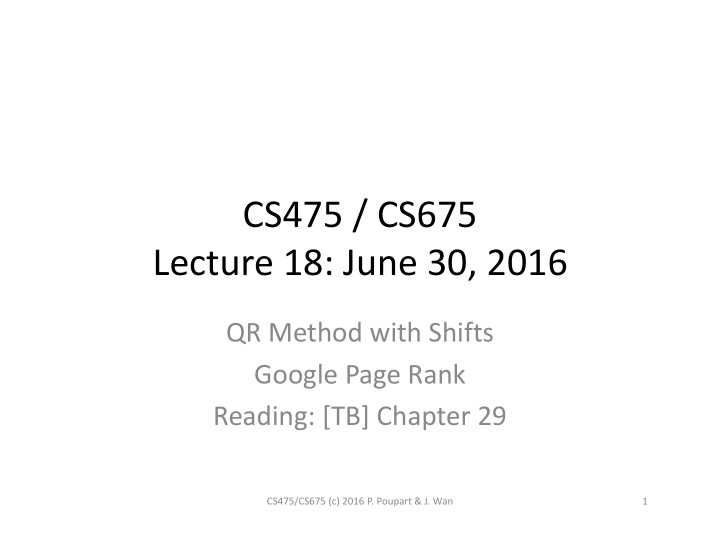



CS475 / CS675 Lecture 18: June 30, 2016 QR Method with Shifts Google Page Rank Reading: [TB] Chapter 29 CS475/CS675 (c) 2016 P. Poupart & J. Wan 1
Reduction to Hessenberg Algorithm For � � 1,2, … , � � 2 � � � � � 1: �, � � � � ���� � � � � � � � � � � � � /| � � | for � � �, � � 1, … , � � � � � � � 1: �, � � � � � � 1: �, � � � � � 1: �, � � 2� � � � end for � � 1,2, … , � � � �, � � 1: � � � �, � � 1: � � 2 � �, � � 1: � � � � � � � � end end CS475/CS675 (c) 2016 P. Poupart & J. Wan 2
Symmetric Case � , then • If � � � is also symmetric • A symmetric Hessenberg matrix tridiagonal matrix • Two‐phase process: CS475/CS675 (c) 2016 P. Poupart & J. Wan 3
Shift QR Algorithm • QR algorithm is both simultaneous iteration and simultaneous inverse iteration – Can apply shift technique • Algorithm (Shifted QR) � � � � For � � 1,2, … Pick a shift � � � � � � ← � ��� � � � � (QR factorization) � � � � � � � � � � � End CS475/CS675 (c) 2016 P. Poupart & J. Wan 4
Shift QR Algorithm • Similar to regular QR, we can show that � � � � � � � where • Derivation: CS475/CS675 (c) 2016 P. Poupart & J. Wan 5
Shift QR Algorithm • We can also show that � ��� � � � • Derivation: CS475/CS675 (c) 2016 P. Poupart & J. Wan 6
Shift QR Algorithm • Continued derivation: • If the shifts are good eigenvalue estimates, the last � converges quickly to an eigenvector. column of CS475/CS675 (c) 2016 P. Poupart & J. Wan 7
Rayleigh quotient shift • To estimate the eigenvalue corresponding to the � : eigenvector approximated by the last column of � � � � � � • Equivalent to applying RQI on � – i.e., QR algo has cubic convergence to that eigenvector � � � � • Note: � � � � � �� � � � comes for free! CS475/CS675 (c) 2016 P. Poupart & J. Wan 8
Google PageRank • Problem: give a ranking, PageRank, to all webpages. • Idea: surfing the web is like a random walk a Markov chain or Markov process. – PageRank = the limiting probability that an infinitely dedicated random surfer visits any particular page. – A page has high rank if other pages with high rank link to it. CS475/CS675 (c) 2016 P. Poupart & J. Wan 9
Google PageRank • Example: CS475/CS675 (c) 2016 P. Poupart & J. Wan 10
Google PageRank • Define connectivity matrix by � �� � � 1 if ∃ a link from page � to � 0 otherwise • The �� column of shows the links on the �� page. CS475/CS675 (c) 2016 P. Poupart & J. Wan 11
Google PageRank • Let prob. that the random walk follows a link and prob. that an arbitrary page is chosen – Typically � � 0.85 � �� � • Define �� ∑ � �� � � to be the prob. of jumping from page to page CS475/CS675 (c) 2016 P. Poupart & J. Wan 12
Google PageRank • Properties of A: – Entries between 0 and 1: 0 � � �� � 1 – Columns sum to 1: ∑ � �� � ∑ � �� � � ∑ 1 � � � 1 � � � � � 1 � � � 1 � � ∑ � �� � • By Ferron‐Frobenius theorem, a matrix with the above properties admits a vector such that i.e., � is the eigenvector corresponding to eigenvalue 1 CS475/CS675 (c) 2016 P. Poupart & J. Wan 13
Google PageRank • Normalize such that . Then is the state � � vector of the Markov chain & is Google’s PageRank! • The elements of are all positive and less than 1. • In our example, CS475/CS675 (c) 2016 P. Poupart & J. Wan 14
Google PageRank • To compute PageRank: – Setup – Compute largest eigenvector by: CS475/CS675 (c) 2016 P. Poupart & J. Wan 15
Recommend
More recommend